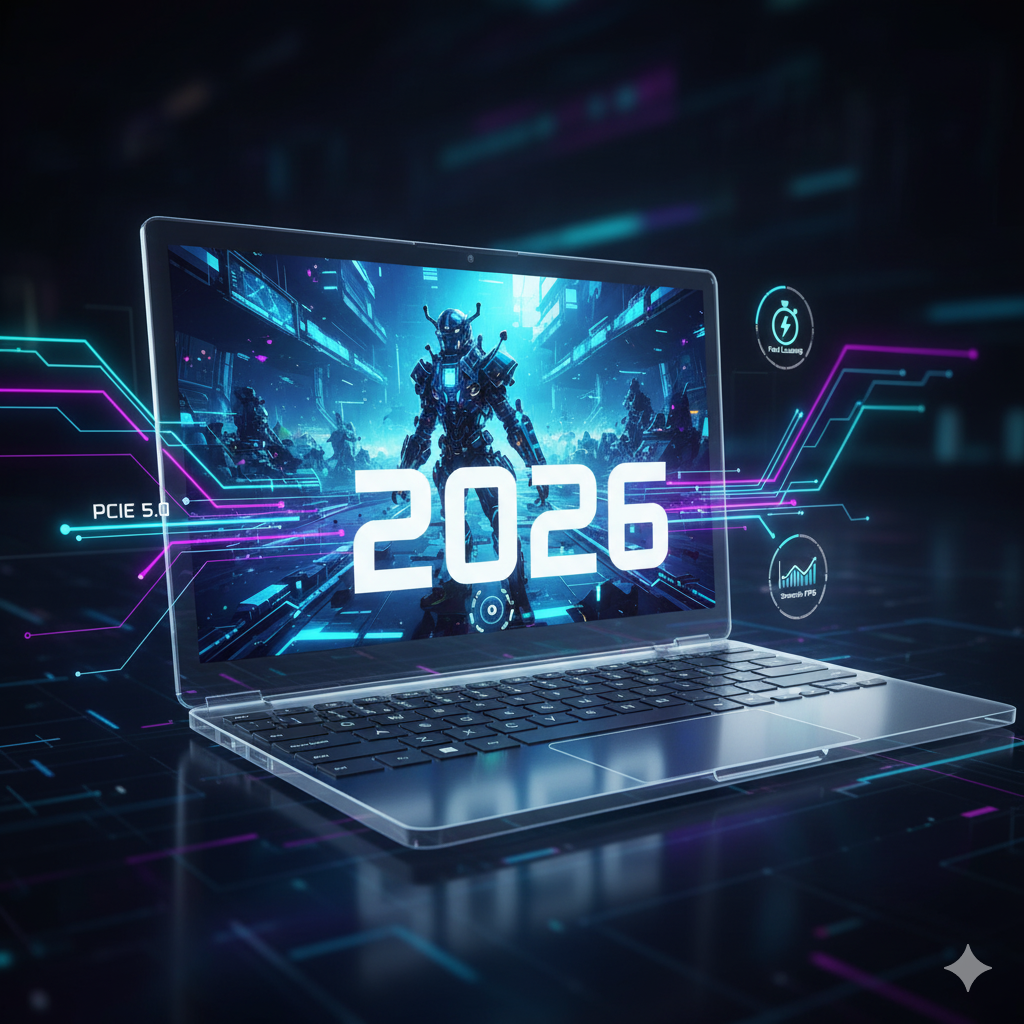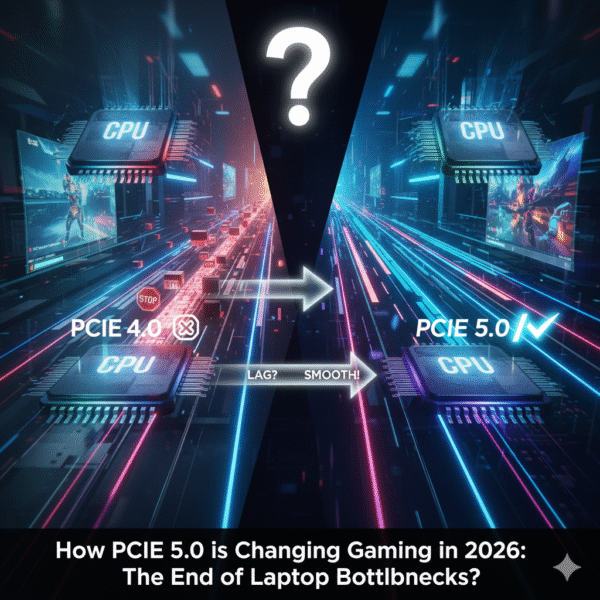Do you remember the days when we would discuss CPU bottlenecks holding back our fine GPUs? Or how slow hard drives would leave us staring at loading screens? Years earlier, those were inevitable considerations in PC gaming. However, in 2026, a silent revolution has been underway under the hood of our laptops, and it is called PCIe 5.0.
This is not merely a question of larger figures on a spec sheet. But of a radical redesign of the flow of data in our machines. So, is PCIe 5.0 essential for gaming laptops in 2026? And will this high-speed link at last eliminate these exasperating CPU and graphics card bottlenecks that we have long fought with? Let’s dive in and see how PCIe 5.0 is truly changing gaming.
1. The Bottleneck Battle: PCIE Speed Matters So Much.
We need to discuss what PCIe is in a moment, but before we do that, we need to provide a brief explanation of the former. Also, imagine it as a high-speed highway within your laptop. Which links all the key components: your graphics card (GPU), your storage drive (SSD), and even other add-on cards, all of them, straight to your processor (CPU).
The PCIe is basically doubled in the number of lanes (and the speed limit on that highway) with every new standard (such as PCIe 3.0, 4.0, 5.0, etc.). When the Ferrari is your GPU, and the country road is your PCIe. You are not going to get anywhere with that Ferrari anytime soon, are you? That’s a bottleneck.
Traditionally, the bottleneck was largely due to the CPU not being powerful enough to match the graphics card, or the hard drive being so slow that it could not run the game. However, as the components become faster and the games increase in size, the PCIe highway itself is then critical.
2. SSDs on Steroids: PCIe 5.0 and the Divine DirectStorage Revolution.
The first and most obvious thing that PCIe 5.0 will change is your laptop storage drive. Older SSDs used PCIe 3.0 or 4.0, which were fast, but PCIe 5.0 M.2 SSDs are on another level entirely, offering speeds that truly push the limits.
Lightning-Fast Load Times with DirectStorage
This incredible speed isn’t just for bragging rights; it’s a key ingredient for a technology called DirectStorage. You might have heard about this from the latest consoles, but it’s now becoming standard for PC games.
Traditionally, when a game needs to load a huge texture or a new part of the world. That data goes from your SSD to your CPU, then the CPU organizes it, and finally sends it to your GPU. This is slow and inefficient.
With DirectStorage technology requirements, PCIe 5.0 SSD, games can grab data directly from the PCIe 5.0 SSD and send it straight to the GPU, completely bypassing the CPU! This dramatically cuts down on CPU workload and, more importantly for us gamers, slashes loading times.
Imagine entering a new game area or fast-traveling and seeing almost no loading screen at all. This is the promise of PCIe 5.0 vs PCIe 4.0 load time difference for next-gen games. For PCIe 5.0 SSDs for DirectStorage benefits gaming, this means not just faster loading, but potentially more seamless open-world experiences with less stutter.
The Trade-off: PCIe 5.0 Thermal Considerations for Laptop Gaming SSDs
Of course, all that speed generates heat. Current PCIe 5.0 SSDs can get quite warm. While desktop PCs can use huge heatsinks, laptops have limited space. Laptop makers are getting clever with cooling solutions, but it’s something to keep in mind. Look for laptops that specifically mention advanced thermal pads or even small vapor chambers for their M.2 SSD slots if you want to take full advantage of these blazing-fast drives.

3. Feeding the Beast: How PCIe 5.0 Elevates GPU Performance
The other main component connected by PCIe is your graphics card. And let’s be honest, that’s the heart of any gaming laptop. While your GPU usually isn’t bottlenecked by PCIe 4.0 in most current games, that’s changing with the demands of 2026’s titles.
Eliminating the GPU Starvation Diet
As GPUs become incredibly powerful, especially the upcoming RTX 50-series and AMD’s next-gen mobile chips. They demand more and more data from the CPU. If the PCIe highway isn’t wide enough, the GPU effectively starves, waiting for instructions and textures.
This is where PCIe 5.0 GPU bandwidth’s effect on high refresh rate gaming comes in. If you’re playing at 1440p or 4K with a 144Hz or even 240Hz screen. Your GPU is churning out massive amounts of data every second. PCIe 5.0 provides the super-wide connection needed to keep that data flowing without interruption, ensuring your expensive GPU is working at its absolute peak. This helps prevent those frustrating micro-stutters that spoil high refresh rate gaming.
Does PCIe 5.0 Eliminate CPU Bottleneck in Gaming?
While PCIe 5.0 can’t magically make a weak CPU into a super-CPU. It does significantly reduce the chances of your CPU getting overwhelmed by data transfer. By allowing more efficient data movement directly to the GPU (especially with DirectStorage). The CPU has less work to do managing those transfers. This translates to more CPU headroom benefits with a PCIe 5.0 GPU laptop, meaning your CPU can focus its power on game logic, AI, and physics, rather than shuffling files around.
This all contributes to a smoother overall experience and definitely helps in PCIe 5.0 bottleneck removal for high-end GPUs, especially when paired with powerful next-gen CPUs. It means the parts of your laptop can communicate without tripping over each other.
4. The Future is Fast: Games That Will Actually Need PCIe 5.0
So, what kind of games will truly make use of this speed? The trend is clear:
- Massive Open-World Games: Think of vast, incredibly detailed environments that need to stream new assets constantly. Games that will utilize PCIe 5.0 bandwidth in 2026 are likely these sprawling epics.
- Next-Gen Graphics: Titles pushing Unreal Engine 5 or similar high-fidelity engines will leverage every bit of bandwidth for textures, lighting, and complex geometry.
- Faster Loading & Seamless Transitions: As mentioned, DirectStorage means less waiting and more playing, making the game flow much better.
- Improved 1% Lows: This is a subtle but crucial benefit. While average FPS might not shoot up dramatically, the consistency offered by PCIe 5.0’s faster data flow can significantly improve 1% low FPS in gaming laptops, leading to a much smoother, stutter-free experience.
5. Should You Upgrade? PCIe 5.0 Future-Proofing for Your Gaming Laptop
So, given all this, should I upgrade to a PCIe 5.0 gaming laptop 2026? It’s a big question with a nuanced answer.
For the Casual Gamer: If you primarily play older titles or less demanding games, PCIe 4.0 is still perfectly fine and will be for some time. You probably won’t feel the difference enough to justify a full upgrade.
For the Enthusiast & Competitive Gamer: If you’re building a top-tier machine in 2026, especially for 1440p/4K gaming, high refresh rates, or playing the latest, most demanding AAA titles, then a PCIe 5.0 future-proofing gaming laptop is a very smart move. It guarantees that your CPU and GPU are not limited by the data highway, and you will enjoy the full potential of DirectStorage.
The Cost vs. Performance: Currently, PCIe 5.0 components (especially SSDs) carry a premium. You need to weigh the cost vs performance of PCIe 5.0 gaming laptop components carefully. All these will be more affordable and prevalent, though, as 2026 moves on.
The Verdict:
Although not all gamers may need it at present, PCIe 5.0 is nothing more than a marketing buzzword. It is an important base technology that enables the next-gen GPUs and SSDs to do all they can. In 2026, when you are buying a high-end gaming laptop, you can make sure that you are using PCIe 5.0 to ensure that your high-performance elements can communicate at that rapid speed to provide a truly flawless and bottleneck-free gaming experience over the next few years. It is about creating a machine that is capable of actually dealing with whatever 2026 and beyond puts before it.



